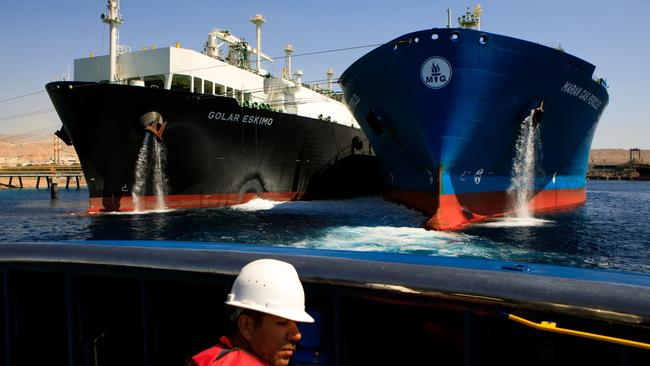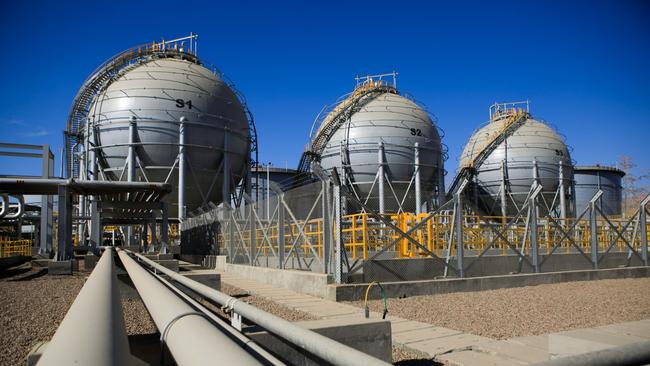Rush to import gas as supply crunch looms
Years of appalling policy and red tape restrictions have led to a gas supply crunch in the lower eastern states that is unlikely to be resolved soon.

There was a pivotal moment in the fracking-driven US gas revolution when Charif Souki, investment banker, former restaurant owner, skiing enthusiast and later America’s best paid chief executive, decided to transform Cheniere Energy’s gas import terminals into export terminals.
New technology had turned the US’s gas drought into a flood, and as The Wall Street Journal’s Gregory Zuckerman described with cinematic zeal in his book The Frackers: The Outrageous Inside Story of the New Billionaire Wildcatters, entrepreneurs such as Mr Souki were there to make hay while the gas flowed.
Somewhat perversely, given Australia’s abundant supplies of gas, we seem to be on the cusp of the opposite phenomenon in Australia.
Many years of what resources industry insiders describe as appalling policy and red tape restrictions have led to a gas supply crunch in the lower eastern states that is unlikely to be resolved soon.
Driven by concerns about the environmental impacts of fracture stimulation – or fracking – Victoria went so far as to ban all onshore gas exploration, including conventional exploration, in 2014.
That ban was lifted in July this year, but the Andrews government announced in March it had banned fracking and coal-seam gas extraction “forever” by enshrining the ban in legislation.
More importantly, supply from the offshore Gippsland Basin – which has supplied cheap gas to Victoria for decades – is in decline, and the gas-hungry residential and commercial customers of Victoria face imminent supply shortfalls.
The Australian Energy Market Operator (AEMO) has previously forecast winter gas supply shortfalls from 2024, but this year warned that if the proposed Andrew Forrest-backed Port Kembla gas terminal was delayed, “southern supply scarcity risks have emerged for winter 2023 under certain conditions’’.
The Australian Competition & Consumer Commission this month updated its own forecasts, saying gas supply for the east coast market next year was “finely balanced”, even “precarious”, with a shortfall of up to two petajoules possible if LNG producers export all of their excess gas.
The fragility of the system is already evident, with industry sources saying the Victorian gas price recently briefly spiked to more than $50 per gigajoule on a day when cold weather combined with a lack of supply from wind turbines. This compares with spot prices, according to the Australian Energy Regulator, of $5.60-$6.54 across markets last financial year.
Further north, NSW has its own problems.
Santos chief executive Kevin Gallagher has been frustrated for years about the delays facing the company’s Narrabri coal-seam gas project, in which it has invested north of $1.5bn.
Narrabri, which Santos argues would go a long way to easing gas supply constraints at least in NSW, is approved but facing a last-minute legal challenge on climate change grounds, with an appeal against its approval scheduled for Monday.
Mr Gallagher says a system which demands companies invest at the front end, while still running the risk of having the regulatory rug pulled out from under them at the last minute, is flawed.
Given all the headwinds in getting gas out of the ground, and with domestic gas prices rising over recent years, our own entrepreneurs and energy companies are looking to help out by importing gas through new import terminals in the form of floating storage and regasification units (FSRU).

Just last week Viva Energy said it was on track to make a final investment decision on a $250m-$300m LNG terminal at its Geelong energy campus by next year, subject to environmental approvals.
The need for a Victorian import solution has firmed up since AGL’s plans for a terminal at Crib Point were abandoned in May, following the state planning minister’s determination that it would have “unacceptable environmental effects’’.
But with Viva’s plans centred on an existing industrial site, the company, which intends to submit its Environment Effects Statement in early December, is confident it can get its project approved.
Lachlan Pfeiffer, Viva Energy’s chief business development and sustainability officer, said while a number of import terminals had been proposed, the need for a solution to start delivering into the market was approaching fast.
And with Viva’s project adjacent to a residential and industrial customer base, its fundamentals were advantageous compared with projects that might need to pipe gas from SA or NSW.
“Putting the best source of gas next to the greatest demand makes the most sense,’’ he said.
“Victoria is a very heavy gas user. Melburnians, because we’ve had the very cheap gas from the Gippsland Basin for the last 30 or 40 years, we’ve built up a gas demand that’s out-weighted compared to any other state.’’
Viva envisages two import projects on the east coast coming to fruition and is confident it will own one.
The other most likely contender is the Port Kembla project, which it was reported recently is four months into major construction, although contracts with customers are yet to be announced.
Viva expects to make a final investment decision next year, and potentially have gas into the market by 2024.
Mr Pfeiffer said potential users of an import terminal were very interested in the project, and Viva might also go down the route of becoming a gas importer in its own right.
Over the border in South Australia, Venice Energy, which has IPO aspirations and is led by former senior bureaucrat and BHP executive Kym Winter-Dewhirst, wants to look at making the SEA Gas pipeline connecting SA with Victoria bi-directional, to help the latter with its supply issues.
“Our project will provide competitively priced new gas supplies into both South Australia and Victoria,” he said. “Making the existing Victorian/South Australian pipeline bi-directional makes sense, especially as Victoria is the nation’s largest consumer of gas and faces the deepest cuts to domestic supplies.’’
Venice wants to park an FSRU, supplied by Greek company GasLog, at Port Adelaide, and expects planning approvals for the $200m project this year. The company recently said if things went as planned it could be plugged into SA’s gas supply network by “the end of 2022 to early 2023’’.
Shareholders in that project include Singapore-based Pieter Le Roux, a former BHP vice president and current head of consulting at Cyient, Damien Brown, head of consulting with IG Partners based in Brisbane and also a BHP alumnus, and Mr Winter-Dewhirst himself.
Venice has previously said a possible IPO backed by institutional investors is likely to provide funding to build the project. Up at Port Kembla, the project seemingly suffered a setback recently when the head of Mr Forrest’s Squadron Energy unit resigned, with Australian Industrial Energy (AIE) which is building the gas terminal, falling under Squadron’s umbrella.
AIE has signed a 25-year lease deal at Port Kembla and plans to build an 800 megawatt LNG and hydrogen power station in the Illawarra, initially powered with gas from the import facility.
The $250m gas import project is yet to announce major customer contracts, but Mr Johnston was recently quoted as saying all major construction contracts had been awarded and it was on track to be finished by the end of 2022.
Korean firm Epik is planning an import terminal at Newcastle. It says it is preparing an environmental impact statement was ongoing, and “we anticipate obtaining all necessary approvals in advance of taking a final investment decision by end of 2022’’.
“We expect operations of the GasDock terminal to begin in 2024/5, in line with the market, though there is flexibility built into our schedule that could allow operations to start earlier,’’ a spokesman said.
Dutch company Vopak is also working on a proposal to station an FSRU in Port Phillip Bay, 19km offshore from Avalon North.
It is expected to soon submit a proposal to the Victorian government. The scheme would involve a subsea pipeline bringing gas onshore to connect with existing pipeline infrastructure.
And while it seems likely Australia will have its first gas import terminal up and running sometime in the next couple of years, energy market consultancy EnergyQuest points out that risks to supply still remain high.
“(Port Kembla) and other developments are not in the bag by any means and in their absence the southern states would be hostage to whatever the weather gods decide to dish up,’’ its report says.






To join the conversation, please log in. Don't have an account? Register
Join the conversation, you are commenting as Logout